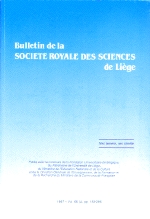"Les strychnos africains et leurs alcaloïdes"
Clément Delaude and Lionel Delaude
 |
source: Bulletin de la Société Royale des Sciences de Liège
year: 1997
volume: 66
first page: 183
last page: 286
language: French
doi: not available
|
Abstract: In the Greek Antiquity, the term strychnos was first coined to describe various toxic Solanacae. Nowadays, the genus Strychnos created by Linnaeus in 1753 is the numerically most important genus from the Loganiaceae family and comprises 196 species growing in the warm regions of Asia (58 species), America (64) and Africa (75). Species on the three continents are almost totally segregated. Only Strychnos potatorum is common to Asia and Africa. The toxicity of Strychnos was empirically well-known from time immemorial. Inhabitants of South-Eastern Asia and India had an ancestral knowledge of Strychnos nux vomica, whose deadly poisonous seeds were later imported and marketed in Europe to kill rodents and small predators. Concentrated extracts from Amazonian Strychnos, known as curares, are also remarkable hunting poisons, used by South American Indians. Accordingly, modern scientific investigations of Strychnos and their alkaloids started with Asian or American species used as traditionnal poisons. Strychnine was the first alkaloid found in Strychnos. It was isolated from Asian S. nux vomica in 1818, but its structure was fully elucidated only in the 1950s. Meanwhile, various curarizing alkaloids from American Strychnos were identified. Based on these early results, Strychnos alkaloids were initially classified according to their geographical origin. Asian Strychnos were assumed to contain strychnine and related compounds, whereas curarizing ammonium salts were associated with American Strychnos. African species were assimilated to their Asian counterparts and deemed of less interest. During the last three decades, however, systematic screening of African Strychnos has revealed the presence of numerous, varied alkaloids in these plants and demonstrated that the correlation between geographical distribution and alkaloid content was erroneous. Presently, 47 African species have been investigated and their alkaloids analyzed, significantly more than Asian and American materials (about 10 and 20 species, respectively). In this review, we present the alkaloids isolated so far from African Strychnos. 309 structures are listed and sorted according to their molecular weight, the most useful index key in modern research based on mass spectrometry.
Keywords: Strychnos, Loganiaceae, Alkaloids
[Full Text] [<< Previous Article] [Back to the List of Publications] [Next Article >>] l.delaude@ulg.ac.be